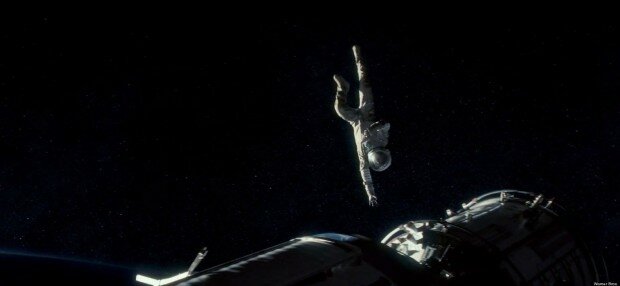Space exploration on film may never be quite the same after “Gravity”.
Alfonso Cuarón’s ninety-one minute thrilling adventure took years in the making, and all of that work appears to have paid off. The film wastes zero time attempting to draw you into the atmosphere, literally. Beginning with a thirteen minute shot that introduces us to the astronauts (played by Sandra Bullock and George Clooney) and ending in utter chaos, Cuarón has crafted a paralyzing thriller that simultaneously uses agoraphobia and claustrophobia to disorient and terrify its viewer. The tightly bound screenplay (also written by Cuarón; intermittent with his son Jonas) does not leeway into heavy backstory or fluff. For this choice some may find fault, however, “Gravity” does well to keep the audience’s attention in check and focused on the ever-mounting dangers of our universe.
The catastrophic event that takes place in the film is loosely based on a concept discussed by NASA in the late 1980s, which involved the Russian’s shooting their old spy satellites out of the sky. The event, they feared, would conclude with either a missile or a downed satellite colliding with another orbital structure, causing a chain reaction of debris to orbit at a high velocity around the planet. “Gravity” runs on this premise and does well to not depict itself the same way most blockbusters do (with concussive booms and thunderous noise). The filmmakers wanted to display space as expansive, empty, and in many ways, a monstrous void. Explosions are realistically muffled. The most audible scenes may be the characters panicked breathing, but Steven Price’s score only aids in this by using impressive orchestrated tones. So often with mega movie calamities, viewers’ experience desensitization to grand visual destruction. It’s exceptionally refreshing seeing (and feeling) the weight and terror of a hyper realistic event unfold so beautifully on screen.

Via: empireonline.com
As mentioned previously, viewers do not become overly attached to the characters given. “Gravity” is unique in that it is much more concerned with placing you alongside these people in their plights. The viewer transcends voyeurism and becomes a participant. By not filling the two main astronauts with extra components (personal problems) it makes us feel more connected to the present dangers. Most of the dialogue is serving to keep those characters emotionally motivated to carry on. This does include a small back story for Bullock’s Dr. Stone, but only because it is essential to the conclusion of the film. One probably wouldn’t focus on a lot of emotional hang ups when trying to survive in space anyway.
The tech wizardry behind “Gravity” will likely be the most talked about aspect of the film for a while. Long time Cuarón collaborator Emmanuel Lubezki shot the film using innovative camera rigs–similar to the machines used to assemble cars–to create near perfect floating-in-the-bowels-of-space motion shots. The CGI chosen in “Gravity” uses hyper photo-real images already taken of space.
Combining the rigs and computer imagery solidifies “Gravity” an artistic marvel and a breathless, thrilling survivor epic. It is a grand theatrical experience and will be unlike anything you may see in a very, very long time.
Photo courtesy of: AwardsDaily





